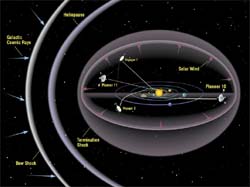
High-resolution data near the termination shock (TS) crossings (shaded regions).
Analysis of data from spacecraft Voyager 2 shows that the solar wind, when collides with interstellar medium to enter the Solar System's final frontier, the heliosheath, turns out to be faster and cooler than scientists had previously expected. This state-of-the-art research by US space physicists and Prof. WANG Chi from the CAS-affiliated State Key Laboratory of Space Weather is reported in the July 3 issue of
Nature.
A supersonic flow of plasma emitted by the Sun, the solar wind gradually decelerates as it travels farther and farther away from its source and goes through a "termination shock" when its velocity falls under subsonic. Thirty yearly after the NASA launch of Voyager 1 and 2, the twin spacecrafts encountered their termination shock respectively in 2004 and 2007, and sent back to Earth precious data which enable scientists to carry out in situ observation on this mysterious borderland. Since the shock was not static and fluctuates considerably with local pressures, Voyager 2 led several crossings in last summer to enter the heliosheath, before finally to pierce the heliosphere into the Galaxy.
Research scientists John Richardson, Justin Kasper and Wang Chi analyzed relevant data on the speed and temperature of the solar wind flow at the termination shock. Unexpectedly, they discovered that the flow remains supersonic after the shock, and that the temperature observed is 1,000,000K in the heliosheath. This challenges previous beliefs in a subsonic speed of the solar wind and temperature at about 10,000,000K.
To explain this phenomenon, the scientists proposed a significant role of neutral particles in the interstellar medium. Large amount of neural interstellar particles are ionized into "pickup ions" through charge exchange with protons of the solar wind, and receive about four fifths of the solar wind energy during the shock. As a result, the plasma velocity detected by the spacecraft in downstream is no longer that of the thermal plasma, but is determined by the properties of those hot pickup ions which travel faster than the flow.
These are not the only amendments to our space theories, though. For instance, data shows that Voyager 2 had its termination shock at a distance about 84 AUs (astronomical unit, 1AU = Sun-Earth distance or about 150 million kilometers) away from the Sun while Voyager 1 had its shock at some 94 AUs. Thus, the boundary turns out to be not as symmetrical as we had imagined, probably due to local magnetic pressures, scientists say.
Thanks to the good operation conditions of Voyager 2, we are able to receive enormous data and gain more scientific understanding about the Universe. And we can expect still more amazing feats of the spacecraft before its shutdown in 2020.
The paper is one of a series of five articles published in the July 3 issue of
Nature which focuses on latest solar wind termination shock studies supported by Voyager 2.
Prof. Wang Chi obtained his PhD in physics from MIT in 1998. He worked as a postdoc there and was became research scientist in 2000, mainly responsible for data analysis and modeling of the heliosphere in NASA exploration program Voyager. Not long after that he was recruited to the CAS through
Bairen Program as head of the Laboratory and PI of space weather prediction method and modeling.
Professor John Richardson is currently a visiting scholar at Prof. Wang's Lab. As Principal Investigator of the Voyager Plasma Experiment, he works in the Space Plasma Group at the Center for Space Research, MIT.







